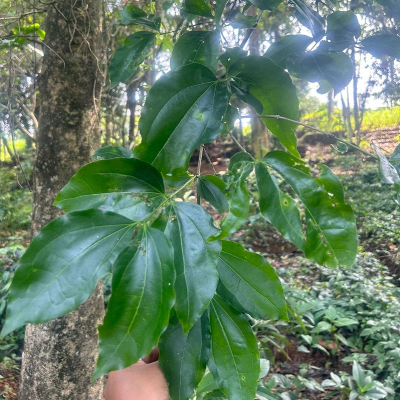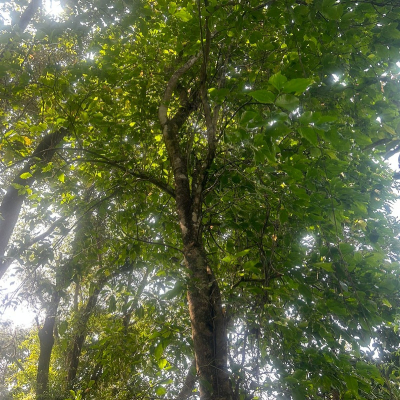Distribution and habitat: Throughout India in deciduous forests up to 1200 m. It is also found in Sri Lanka, Siam, Indochina and Malaysia.
Botany: It is a large deciduous tree, with simple leaves and white fragrant flowers.
- Leaves: Simple, opposite, orbicular to ovate, coriaceous, glabrous, 5 nerved, apex obtuse, acute or apiculate, transverse nerves irregular and inconspicuous.
- Inflorescence: Many flowered terminal cymes, 2.5-5 cm across. Bracts (5 mm) and bracteoles (1.5 mm) small. Flowers are white or greenish white and fragrant. Calyx 5 lobed, pubescent and small (2 mm). Corolla salver shaped, tube cylindrical slightly hairy near the base within and greenish white, tube much elongate than the lobes. Stamens 5, filaments short.
- Fruit: A berry, 5-6 cm diameter, globose, indehiscent, thick shelled, orange red when ripe with fleshy pulp enclosing the seeds.
- Seeds: Seeds orbicular, flat, shiny, greenish white, coin like, 2-2.5 cm diameter, covered with fine grey silky hairs. Seeds mature in 8 - 9 months after flowering during December- June. Seeds have a dormancy of 4-6 weeks and viability up to 1 year
Properties: Spasmolytic, muscle relaxant
Chemical constituents:
- Seeds contain strychnine, Brucine, α and β-columbrine. Isostrychnine, Pseudostrychnine. Glucoside- Loganin.
- Flowers contain Brucine, Icajine, Novacine, Strychnine, Vomicine and fruit pulp (phenolic glycoside) - Cuchiloside and Salidroside
Uses: In small doses it can serve as efficacious cure forms of paralysis and other nervous disorders.
- The seeds are used as a remedy in intermittent fever, dyspepsia, chronic dysentery, paralytic and neuralgic affections. It is also useful in impotence, neuralgia of face, heart disease.
- Leaves are applied as poultice in the treatment of chronic wounds and ulcers and the leaf decoction is useful in paralytic complaints.
- Root and root bark used in fever and dysentery.
Formulations: Samirgaja keasri hab khas
Agrotechnology
Soil and climate: It survives in lateritic soil. The tree prefers a warm tropical climate.
Propagation: It is propagated through seeds and vegetative propagation. Soak seeds in water overnight before sowing. It takes 30 days for germination.
Spacing : 5 m x 5 m
Seed requirement per acre : 0.3 kg
Seedlings required per acre : 160 nos.
Harvesting: The leaf fall is during December (do not shed all the leaves at a time) and new foliage appears in February. Flowering is during March - April and fruiting during May - December. Fruits take about 8-9 months to mature.



